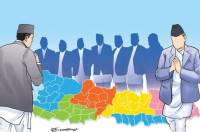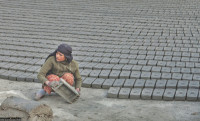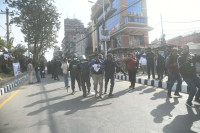Opinion
The communist dream
The CPN-UML and CPN-Maoist Centre have been intense rivals over the past decade, possessing drastically different worldviews and constituencies. Both parties have the word ‘communist’ in their names, but this hasn’t result in much commonality.
Aditya Adhikari
The CPN-UML and CPN-Maoist Centre have been intense rivals over the past decade, possessing drastically different worldviews and constituencies. Both parties have the word ‘communist’ in their names, but this hasn’t result in much commonality. The UML can hardly be said to be communist at all: many decades have passed since it accepted multi-party competition and agitated on behalf of the poor and oppressed to upend the status quo. And the Maoists may have kept the idea of a revolutionary dictatorship alive since the party emerged from an armed movement not too long ago, but the party is now assimilated into the multi-party system and is in no position to achieve its latent goals. The Maoists have for much of the past decade supported radical decentralisation through federalism. The UML has been their staunchest opponent. Yet recently the two parties not only decided to form an electoral alliance, but also agreed to eventually merge and form the largest and strongest communist party this country has ever seen.
So in their perception at least, Maoist and UML leaders think they both uphold the tenets of communism, which distinguishes them from all other political groupings. Their supporters seem to agree. For them, a merger between the UML and Maoist Centre appears more natural than, say, one between the Maoist Centre and the Nepali Congress, even though the latter two are closer to each other on a number of critical issues. What then is this thing called communism that the UML and MC share?
Tenuous bonds
For one, many of the older UML and MC members have common social origins. Both parties are primarily led by Bahun and Chhetri men from peasant backgrounds. Their caste status enabled them to thrive in the state education systems in the 1960s and 1970s, but their poor economic circumstances thwarted their aspirations and made them receptive to the Maoist ideology floating around when they were young. The second-tier of these parties also includes members of hill Janajati groups, which both the UML and MC promised to liberate at different times in the past. For decades, members of the two groups participated in small communist outfits that often had fractious relationships but also had deep bonds in a milieu shaped by state repression.
But a psychological bond of this nature is a tenuous basis for the merger of two of the largest parties in Nepal today. What really distinguishes the UML and MC from other parties in Nepal is their Leninist party organisation. In a nutshell, this consists of a centralised and hierarchical party structure with a permanent body of cadres. Engaged in a wide range of affiliate organisations, such cadres not only seek to mediate between the population and the organs of the state but also on occasion directly take on responsibilities (such as policing and arbitration) that are the prerogative of the state.
The Maoists had a strong Leninist-style organisation during the war and in the early years of the peace process. Their army, parallel governments, courts and ethnic fronts, and later the Young Communist League (YCL) and trade unions contributed significantly to ensuring Maoist dominance over society. But the peace agreements compelled the party to dissolve its parallel governments and army. Large numbers of YCL cadres and ethnic organisations drifted away in disillusionment. The Maoists’ old sources of power withered away.
For much of the armed conflict, the Maoists’ core constituency was composed of peasantry tied to the land and subject to exploitation by landlords and moneylenders. Transformations in Nepali society have led to a steady erosion of this support base. Landholdings have fragmented, diminishing the power of the traditional landlord class. The peasantry has become mobile, having migrated to urban areas within Nepal as well as countries in the Gulf region and beyond. Traders and contractors have replaced landowners as the dominant class in large parts of the country.
This is a class whose support the UML is perfectly positioned to capture. The great strength of the UML today is the creation of strong networks among sections of society that were not inherently influential a generation ago. These include not just traders and contractors, but NGO workers, employees in the lower to middle rungs of the bureaucracy and criminal gangs that extort rent. It is commonly thought that the primary task of the political party is to ensure the flow of patronage out from Singha Durbar down to villages. In addition, however, the UML has combined such patronage with horizontal associational bonds. For example, the UML-affiliated bus owners might seek the help of the UML ‘youth wing’ (in reality an agglomeration of underemployed men with criminal tendencies) to protest against government regulation. Or a UML-affiliated NGO head might surreptitiously recruit the son of a minor bureaucrat to a job funded by international donors. Or local UML politicians might plan to grant a tender to construct a road to a UML-affiliated contractor.
In this way, the UML’s networks maintain a stranglehold over transactions in society, leaving non-affiliated elements no chance to compete. This is what the UML’s Leninist organisation has evolved into. As in other communist regimes in history, this model of political organisation, originally meant to ensure the dominance of the proletariat in all spheres, has gradually turned into a network of mutual benefit for party apparatchiks.
Redefining Nepali communismMany people involved in the UML’s networks are old leftists from peasant backgrounds. They still proudly think of themselves as communists. But having benefited from the UML being in power, they are no longer opposed to the status quo. Rather, their aversion is directed towards Madhesi and Janajati groups that demand self-governance and greater representation for their communities. The UML supporter can justify this stance by arguing that communism is meant to speak for the poor everywhere, and not for any particular caste or ethnic group. For, in their minds, they are still poor and they still hold grievances towards vaguely defined elite groups. Periodically they relieve themselves by lashing out at perceived enemies of national interest: Indians who supposedly want to use the Madhesi population to ensure India’s dominance over Nepal, Europeans who ostensibly want to fragment Nepal by creating a federal structure, or missionaries intent on converting everyone to Christianity.
The decision to merge the two communist parties indicates that the Maoists are well aware that they cannot compete with the UML’s hold over society. Prachanda must have thought: “Since it’s too difficult to try to gain control of the UML’s constituencies and networks, the best option would be to adopt them as our own.” But there will be a price to pay. The Maoist party, which has already made heavy compromises over the last decade, will be reduced to a mere appendage of the UML. If the two parties do unite, the Maoists will most likely have to abandon all support for identity-based movements, local autonomy and decentralisation.
If the merged party does manage to achieve a majority in the next election, they will finally be in a position to move towards what all communist parties in Nepal have always desired: centralisation of power in the hands of the party and a monopoly over all sections of society. They will try to ensure that there is no civil society, only groups directly affiliated to the ruling parties. They will likely coax and coerce the media to work as propagandists for the regime. All encroachments on democracy will be justified on the basis of anti-Indian nationalism. These tendencies will then become the defining characteristics of “communism” in Nepal.
Adhikari, former Op-Ed Editor of the Kathmandu Post, is the author of The Bullet and the Ballot Box: The Story of Nepal’s Maoist Revolution




 9.12°C Kathmandu
9.12°C Kathmandu










